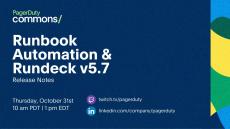|
By Constant Fischer
You can no longer afford to ignore the silent profit killers lurking in your operations. From bloated IT budgets to unplanned downtime and inefficient incident management, these hidden costs can drain your revenue, eroding customer trust, and exposing your company to financial penalties. The solution? A radical shift toward lean and modern Network Operations Centers (NOCs), digital resilience, and a relentless pursuit of inefficiencies.
|
By Laura Chu
Incident management has long relied on ITSM systems designed to handle incidents through a structured ticketing queue, with a focus on compliance and data integrity. While this method brings consistency, it often slows down response times and forces teams into a reactive mode during major incidents. This outdated and fragmented approach creates inconsistencies, as automation tools are inconsistently applied and lack a unified management system.
|
By Laura Chu
Financial entities operate in a complex technical landscape where legacy systems must coexist with modern technologies to meet evolving customer expectations. This interconnected environment introduces vulnerabilities that can lead to IT disruptions, inefficiencies, increased costs, and regulatory risks. High-profile outages, such as those faced by Bank of America and other global institutions, emphasize the critical importance of operational resilience and compliance.
|
By Mitra Goswami
This post was authored by Mitra Goswami, Ralph Bird, Everaldo Aguiar, and Scott Sieper. Over the past two years, generative AI (GenAI) has come a long way, from the early excitement of ChatGPT to early explorations and more and more companies deploying GenAI-powered features into production.
|
By Laura Chu
IT outages are a growing concern for financial entities, threatening both operational resilience and regulatory compliance. These disruptions don’t just create downtime—they also present unique opportunities for learning and transformation. By addressing common challenges and adopting forward-thinking strategies, organizations can turn outages into stepping stones for achieving operational excellence. Breaking down the barriers to incident management A lack of clear ownership.
|
By Constant Fischer
In the fast-paced world of IT operations, myths often masquerade as truths, leading organizations down inefficient and costly paths. Let’s look at five of the most pervasive myths and explore why modern solutions like PagerDuty Operations Cloud are essential for thriving in today’s complex IT environments. Myth 1: Kubernetes is self-healing, and no other tools are required. The Reality: While Kubernetes is often touted as a self-healing platform, this is only partially true.
|
By Laura Chu
Financial entities face increasing complexity in digital operations, making resilience, compliance, and incident management more critical than ever. Heath Newburn, PagerDuty’s Global Field CTO, shares his expertise on tackling these challenges, balancing innovation with compliance, and building operational resilience for lasting success. What are the top challenges that you hear from IT leaders in regulated industries like financial services?
|
By Laura Chu
In an era where regulatory frameworks like DORA and FCA PS21/3 and PRA PS6/21 demand higher standards for financial resilience, European financial entities face growing pressures to ensure compliance and operational excellence. To understand these challenges, we spoke with Lee Fredricks, Director of Solutions Consulting for EMEA at PagerDuty.
|
By Cristina Dias
As we enter 2025, we reflect on a year committed to innovation and customer success at PagerDuty. In 2024, we introduced capabilities that empowered operations teams to mitigate risks, protect customer trust, and improve business outcomes. From managing global outages to addressing complex digital operations, the PagerDuty Operations Cloud enabled organizations to respond faster, work smarter, and build operational resilience.
|
By Constant Fischer
One of the most frequent questions I receive from customers is, “What are the best practices to represent my services in PagerDuty?” This question is not easy to answer, but there is a general consensus that the representation needs to be both accurate and visually appealing. This idea got me thinking about our many customers in the beauty and fashion industry.
|
By PagerDuty
Product Manager Forrest Evans takes us through the new features in Runbook Automation v5.9, including a demo of incorporating Azure Key Vault in your automation jobs. For a full listing of the release notes, see the release notes page. Learn more about automation solutions, including new components to support your FinOps needs on the solutions page.
|
By PagerDuty
PagerDuty acts as the primary interface for real-time actions, seamlessly connecting humans and systems. From the moment a monitoring tool detects a signal to the resolution of an incident, every action is automatically tracked and timestamped. With reduced human error and no risk of missed documentation, PagerDuty provides a reliable, efficient, and transparent incident management solution for financial entities.
|
By PagerDuty
Integrated with robust automated workflows and genAI-enhanced insights, PagerDuty's new chat experience enables end-to-end incident management with guided remediation directly from where responders work. Join Product Managers Jacky Leybman and Michael Wettick to see it all in action!
|
By PagerDuty
Special guest Jeff Hausman, PagerDuty’s Chief Product Development Officer kicks off our 2024 recap for PagerDuty Runbook Automation and Rundeck Open Source. Then Jake and Forrest take us through all of the amazing improvements and new features added to the product, including shout outs to the amazing folks contributing to the Open Source repos and a customer success story from Ryanair.
|
By PagerDuty
It’s a very Kubernetes holiday edition of the Runbook Automation Release Notes. This month we’re talking all about cluster management with new k8s features! View the full release notes on the Rundeck docs site.
|
By PagerDuty
Discover how PagerDuty automates operational workflows across remote physical locations, minimizing in-store disruptions and ensuring seamless customer experiences. Speakers: Corbin Mills (Sr. Solutions Consultant, PagerDuty) & Justyn Roberts (Sr. Solutions Consultant, PagerDuty).
|
By PagerDuty
Join PagerDuty’s Solutions Consultants Bobby Zimmerman and Justyn Roberts to discover how combining technical automation with human-driven processes can reduce manual interventions, streamline repetitive tasks, and increase operational efficiency. Level up your digital operations expertise with PagerDuty Demo Roundups — a series of live, interactive webinars where you can deepen your knowledge in the Operations Cloud and see how PagerDuty can work for you. Each 1-hour session presents a hands-on demo that showcases PagerDuty’s capabilities in real-time followed by Q&A.
|
By PagerDuty
Product Managers Jake and Forrest join us for a spooky stream to talk about the Runbook Automation and Rundeck release v5.7. Project Runner Management is now generally available.
|
By PagerDuty
Join us for an informal 1-hour virtual gathering where the open-source Rundeck by PagerDuty community comes together to share knowledge and insights. Whether you're new to Rundeck or looking to elevate your automation game, this meetup is packed with valuable takeaways for everyone!
|
By PagerDuty
In a world where technology disruptions are no longer a question of “if” but “when,” digital resilience has become essential to business continuity and customer trust. Join us for an insightful webinar featuring Charlie Betz, VP, Research Director at Forrester Research and PagerDuty’s own Tim Chinchen, Sr. Director, Global Solutions Consulting, as they explore strategies to fortify your operational readiness.
|
By PagerDuty
To meet the rising demands of customers, organizations are being forced to scale their operations in ways that introduce additional complexity and chaos. More people are involved in operations and in incident response, across an ever-increasing mix of systems, applications, tools, and layers of abstraction, resulting in more and more risk to the business.
|
By PagerDuty
Given the speed at which technology and consumer expectations are changing, there are now significant gaps in existing ITSM approaches. As a result, ITSM and ITIL processes need to be modernized to address needs around integrating legacy processes and tools, to create workflows that are built around people to maximize flexibility and ease of use.
|
By PagerDuty
This study reviewed a combination of notification statistics and their impact on the well-being and work-life balance of human responders to help answer this question: When does on-call pain lead to employee attrition and how can it be avoided?
|
By PagerDuty
When your monitoring systems generate too many issues that require your attention, your organization starts to suffer from the phenomenon known as alert fatigue. Once alert fatigue sets in, it impacts the services you deliver to employees and customers. Teams become desensitized to alerts, which can cause them to miss critical notifications.
|
By PagerDuty
In this e-book, we introduce a new approach to AIOps that eliminates silos between event and incident management, has helped customers reduce noise on average by 98%, and supports both centralized and distributed workflows in harmony.
|
By PagerDuty
Organizations today require disruption in security management, which means not only modernizing security tools and best practices, but also involving more stakeholders in security ops, streamlining communication about security incidents, and coordinating responses efficiently and rapidly. It means embracing SecOps, a new approach to security management.
|
By PagerDuty
DevOps best practices can benefit all types of organizations, across all industries. Nearly half of enterprises have already begun adopting DevOps, and most of the remainder have plans to do so. If your org doesn't make the shift to DevOps, it risks being disrupted by others that achieve greater agility, automation, and communication.
|
By PagerDuty
In order to continue pleasing your customers in today's rapidly changing digital landscape, you need to adapt your customer support operations to meet this new set of expectations. Instant responses, zero service disruptions, and multiple channels of engagement are the new normal for customer relations. Companies that fail to live up to these ideals risk losing customers and falling behind.
|
By PagerDuty
How critical is incident resolution at your company? When the estimated cost of downtime is $7,900 a minute, how do you ensure you're setting yourself up for success with the right incident management solution?
|
By PagerDuty
From POS systems to QR systems, building management, mobile devices, IoT, and more, retailers must deliver a seamless omnichannel experience to stay ahead of the competition. But are you equipped to provide reliable digital services while continuing to deliver innovation?
- February 2025 (8)
- January 2025 (5)
- December 2024 (5)
- November 2024 (7)
- October 2024 (11)
- September 2024 (8)
- August 2024 (7)
- July 2024 (12)
- June 2024 (5)
- May 2024 (15)
- April 2024 (7)
- March 2024 (12)
- February 2024 (8)
- January 2024 (13)
- December 2023 (6)
- November 2023 (17)
- October 2023 (23)
- September 2023 (16)
- August 2023 (22)
- July 2023 (16)
- June 2023 (19)
- May 2023 (10)
- April 2023 (13)
- March 2023 (4)
- February 2023 (13)
- January 2023 (11)
- December 2022 (10)
- November 2022 (13)
- October 2022 (11)
- September 2022 (12)
- August 2022 (15)
- July 2022 (10)
- June 2022 (12)
- May 2022 (5)
- April 2022 (7)
- March 2022 (7)
- February 2022 (8)
- January 2022 (19)
- December 2021 (9)
- November 2021 (16)
- October 2021 (27)
- September 2021 (11)
- August 2021 (16)
- July 2021 (25)
- June 2021 (17)
- May 2021 (10)
- April 2021 (9)
- March 2021 (18)
- February 2021 (9)
- January 2021 (6)
- December 2020 (9)
- November 2020 (9)
- October 2020 (9)
- September 2020 (12)
- August 2020 (6)
- July 2020 (9)
- June 2020 (15)
- May 2020 (8)
- April 2020 (6)
- March 2020 (9)
- February 2020 (5)
- January 2020 (5)
- December 2019 (2)
- November 2019 (9)
- October 2019 (11)
- September 2019 (11)
- August 2019 (8)
- July 2019 (10)
- June 2019 (11)
- May 2019 (13)
- April 2019 (13)
- March 2019 (14)
- February 2019 (9)
- January 2019 (6)
- December 2018 (9)
- November 2018 (13)
- October 2018 (15)
- September 2018 (15)
- August 2018 (6)
- July 2018 (2)
- June 2018 (11)
- May 2018 (6)
- April 2018 (14)
- March 2018 (1)
- February 2018 (2)
- January 2018 (1)
Enterprise-grade incident management that helps you orchestrate the ideal response to create better customer, employee, and business value.
Visualize every dimension of the customer experience with contextual insights and interactive applications, and optimize response orchestration and continuous development and delivery:
- Event Intelligence: Understand the health and common context of disruptions across your entire infrastructure with actionable, time-series visualizations of correlated events.
- Modern Incident Response: All teams get the same visibility for technical and business response orchestration, enabling better collaboration and rapid resolution.
- Continuous Learning: Discover patterns in performance during build and in production for continuous delivery. View postmortem reports to analyze system efficiency and employee agility.
















